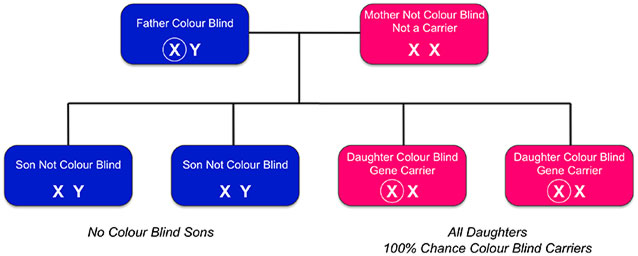1
Question
What is color blindness? explain it's inheritance with help of suitable charts
Open in App
Solution
Colour blindness is a common hereditary (inherited) condition which means it is usually passed down from your parents.
Red/green colour blindness is passed from mother to son on the 23rd chromosome, which is known as the sex chromosome because it also determines sex. Chromosomes are structures which contain genes – these contain the instructions for the development of cells, tissues and organs. If you are colour blind it means the instructions for the development of your cone cells are faulty and the cone cells might be missing, or less sensitive to light or it may be that the pathway from your cone cells to your brain has not developed correctly.
The colour blind ‘gene’ is carried on one of the X chromosomes. Since men have only one X chromosome, if his X chromosome carries the colour blind ‘gene’ (X) he will be colour blind (XY). A woman can have either:-(i) two normal X chromosomes, so that she will not be colour blind or be a carrier (XX),(ii) or, one normal X and one colour blind carrying X chromosome, in which case she will be a carrier (XX), or rarely(iii) she will inherit a colour blind X from her father and a colour blind X from her mother and be colour blind herself (XX). She will pass on colour blindness to all of her sons if this is the case.

Colour blindness is a common hereditary (inherited) condition which means it is usually passed down from your parents.
Red/green colour blindness is passed from mother to son on the 23rd chromosome, which is known as the sex chromosome because it also determines sex. Chromosomes are structures which contain genes – these contain the instructions for the development of cells, tissues and organs. If you are colour blind it means the instructions for the development of your cone cells are faulty and the cone cells might be missing, or less sensitive to light or it may be that the pathway from your cone cells to your brain has not developed correctly.
The colour blind ‘gene’ is carried on one of the X chromosomes. Since men have only one X chromosome, if his X chromosome carries the colour blind ‘gene’ (X) he will be colour blind (XY). A woman can have either:-
(i) two normal X chromosomes, so that she will not be colour blind or be a carrier (XX),
(ii) or, one normal X and one colour blind carrying X chromosome, in which case she will be a carrier (XX), or rarely
(iii) she will inherit a colour blind X from her father and a colour blind X from her mother and be colour blind herself (XX). She will pass on colour blindness to all of her sons if this is the case.

Suggest Corrections
0
View More
Join BYJU'S Learning Program
Join BYJU'S Learning Program
